To common and popular ways to correct a number of defects the structure of the jaw in the oral cavity includes clasp prostheses. Unlike the implantation of ceramic teeth, the procedure allows for faster, more painless and an order of magnitude cheaper to correct the existing deficiencies. Photos of the usually obtained results confirm the success of the technique among orthodontists.
Record content:
- 1 What are clasp prostheses?
- 2 Manufacturing steps and installation
-
3 Main types
- 3.1 Splinting structures
- 3.2 On locks
- 3.3 On clasps
- 3.4 On telescopic crowns
- 3.5 On the beam
- 3.6 Quadrotti system
- 3.7 Unilateral
- 3.8 Removable clasp prosthesis
- 3.9 With the complete absence of teeth
- 4 Features of the installation of prostheses
- 5 Indications and contraindications
- 6 Subtleties of care
- 7 Video about the clasp prosthesis
What are clasp prostheses?
Clasp denture on the jaw, a photo of which can be found for each specific type, is removable or non-removable construction, which is based on the use of a clasp - a special arc made of metal with elements fixed on it from plastics. Ultimately, the prosthesis completely mimics an outwardly healthy jaw.
Manufacturing steps and installation
The structure consists of several separate parts, which ultimately are firmly fixed to each other:
- carcass - most often the element is made from a mixture of cobalt with chromium;
- the foundation - made of acrylic, teeth made of polymers are fixed on it;
- retainers - a special system for securing the entire structure.
The metal frame allows you to create and fix a clasp prosthesis only in the presence of several healthy teeth. The main advantage of the resulting design is that it is thinner than that of a standard prosthesis. At the same time, the molded form eliminates discomfort during wearing.
Technically, the manufacturing and installation procedure is quite complex, so this can be done by only qualified specialists who are able to take into account even small features of the structure of the jaw in the patient.
This process can be divided into 2 stages:
- clinical;
- laboratory.
At the clinical stage, the patient must visit the specialist's office several times:
- at the beginning, an examination of the oral cavity and an assessment of the severity of the situation will be required;
- this process allows you to obtain objective data on the presence of abutment teeth;
- also at this time, treatment of all existing pathologies may be required;
- in some cases, preliminary turning can be additionally performed;
- at the end of the examination, the doctor will make an impression of the jaw to create a prosthesis.

Immediately after receiving data on the state of the oral cavity and the degree of existing defects, the specialist will start making one of the types of clasp prostheses. After readiness, fitting, fitting and direct fixation on the patient's jaw will be required. This will only happen if there are no complaints about discomfort or other complaints on his part.
The procedure for examining the oral cavity itself includes several target areas:
- assessment of the peculiarities of the bite, which allows you to correctly determine the location of the teeth on both jaws;
- determination of the load on the abutment teeth that will be used as carriers of the prosthesis;
- after that, the specialist will start creating a graphical model to select the optimal design;
- it is possible to simulate the teeth turning procedure at this stage, in the future its implementation will be required;
- the processed plaster cast is then used as a base to create a metal frame.
After that, the specialist will start casting a real prosthesis, which, after careful processing, will be ready in installation on the patient's jaw and further adjustment, taking into account individual sensations and the smallest features of it buildings.
Main types
In addition to the types themselves, the methods of fixing prostheses are distinguished by separate types:
| View | Description |
| On telescopic crowns | To do this, you need to grind the abutment teeth and install crowns on them that will hold the structure. |
| On clasps | The devices outwardly look like a hook that clings to 2 extreme abutment teeth for 2/3 of their circumference. |
| On attachment locks | Structurally, they are similar to push-button mechanisms that connect the abutment teeth with the prosthesis. |
Regardless of the method of attachment, the oral cavity will be completely sanitized before the procedure.

Modern prosthetic technology offers patients many types of pain relief, including full anesthesia. The cost of procedures varies widely from 50,000 rubles. up to 300,000. rub and above. Basically, the price depends on the type of prosthesis, materials, clinic and specialist qualifications.
Splinting structures
Dentures of this type are recommended when the patient has indications in the form of mobility of the dentition in chronic periodontal diseases. Splinting structures not only imitate lost teeth, but also allow you to keep loose ones.
Externally, the element looks like a stainless steel arch, which fits snugly against the inner surface of the teeth and directly to the gums. Its elements are clasps in the form of links and rings, claw-like processes that securely fix each movable tooth in a row.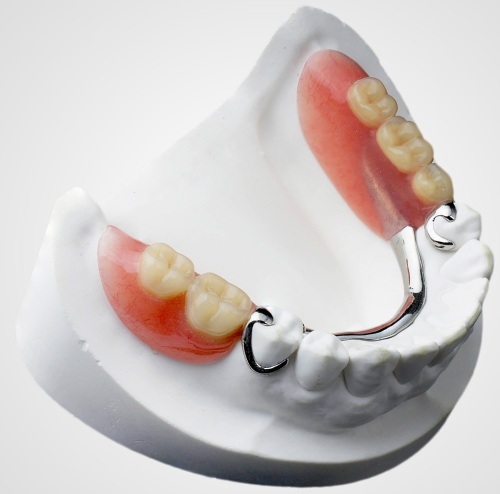
The abutment teeth are then processed and attached to the external crown. As a result, this procedure distributes the chewing load between the prosthesis, loose and healthy teeth, and alveolar processes.
On locks
Microlocks are separate elements, for the installation of which small cavities are made on the sides of the abutment teeth.
To do this, use a special bur with a limiter to exclude the possibility of getting too deep a hole. Therefore, the risk of damaging the internal tissues of the tooth is practically excluded. The outer part of the clasp is then covered with a layer of filling compound.
On clasps
Clasps are special types of fixing elements that can be structures with several parts:
- shoulder - creates sufficient elasticity and mobility of the system and is located around the crown of the tooth, it is absolutely smooth, so as not to injure the surrounding tissues;
- body - the main part of the structure, which, after the installation of the prosthesis, will come into contact with food and drinks;
- scion - helps to fix the prosthesis in a permanent place and is located under the plastic elements.
The resulting structure as a result can withstand everyday stress without any damage.
On telescopic crowns
In this case, the structure of the prosthesis provides for the presence of connecting elements in the form of a telescope. A special feature is the fact that, if necessary, the number of prosthetic teeth can be changed.  These designs are ideal for older people, when the likelihood of losing teeth increases with every goth.
These designs are ideal for older people, when the likelihood of losing teeth increases with every goth.
On the beam
The bar technique got its name due to the presence of a special metal base, which ensures the stability of the finished structure and reliably fixes it in the oral cavity. If necessary, such prostheses can be removed, but this is often unacceptable. Otherwise, the risk of loosening of the teeth increases significantly.
Quadrotti system
The clasp prosthesis on the jaw, the photo of which is the Quadrotti system, is not something exceptional. A separate advantage is the fact that the DENTAL D elastic plastic is used for the manufacture of the prosthesis.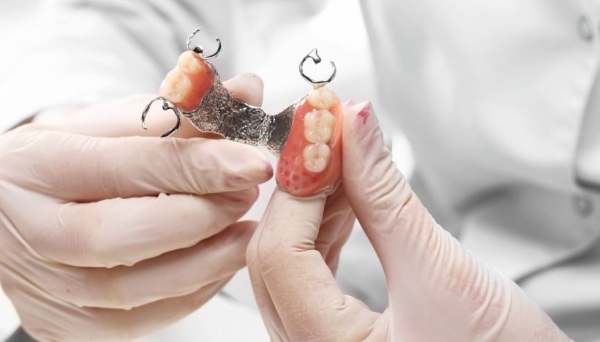
It is absolutely hypoallergenic and outwardly mimics the natural appearance of the jaw as much as possible. Therefore, the Quadrotti system is well suited for those patients for whom the aesthetics of the result is on the first plane.
Unilateral
Prosthetics on only one side of the jaw allows you to restore the functions of the lost teeth. The frame for such a prosthesis looks like an arc. Products can be made for any part of both jaws.
Arc grades also provide a wide range of choices for professionals. If possible, the orthodontist will select the necessary shade to create artificial teeth, which will be as close as possible to the natural color of a particular patient.
Removable clasp prosthesis
Removable systems, simplicity and lightness of designs provide special comfort in the process of using the finished product. Bases of this type not only securely hold the prosthesis in place, but also fully perform the necessary functions of chewing food and creating support for the tongue during a conversation.
With the complete absence of teeth
In such cases, fixed prosthetics are usually recommended to restore all lost functions that cannot be replenished without restoring the entire dentition on both jaws in the patient. Here, only a professional orthodontist with sufficient experience in this direction should decide which one to recommend the prosthesis, its design.
Features of the installation of prostheses
For a complete assessment of the condition of the jaw and dentition, the doctor may recommend a special procedure for obtaining an image - an orthopantomogram. Based on the data obtained, the patient will be given specific recommendations.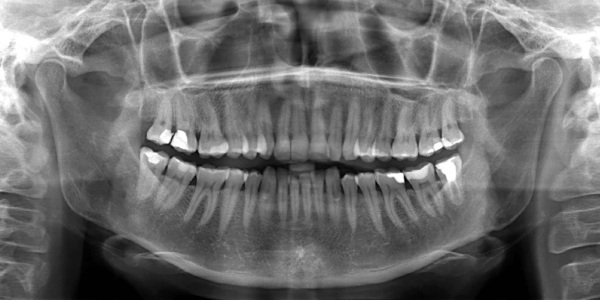
These may include the following procedures:
- professional cleaning to completely eliminate plaque and stone deposits;
- grinding teeth for the capital fixation of crowns and dentures;
- restoration of the integrity of the gingival pockets;
- removal of all foci of carious lesions;
- relieving symptoms of bleeding gums;
- sinus lift before implantation.
It is not possible to describe specifically the installation scheme, since the stages and their duration will largely depend on the individual characteristics of the patient.
Differences in the installation of the upper and lower prosthesis are in the different location of the bridges and retainers. The shape of the arch is largely determined by the typography of dentition disorders, the peculiarities of the palate, reliefs and other factors.
When prosthetics of the upper jaw, the thickness of the bridge is in the range of 0.9-1.2 mm, the width is about 0.4-1 cm. The arch in this area should be half 1 mm from the mucous membrane. In the overwhelming majority of cases, the upper jaw prosthesis is attached to the incisors on the sides or to the molars.
For the lower jaw, the prosthesis is usually performed with an arch, which should extend unevenly from the mucosa. At the top - 0.5 mm, at the bottom - at least 1 mm. In this case, the jumper should not be allowed to come into contact with the surrounding tissues. This is required to avoid possible injury to the tissues of the frenum. In most cases, the attachment is carried out on the lateral incisors.
Indications and contraindications
The only adequate indication for clasp prosthetics is the absence of your own healthy teeth or the ability to use removable options on an ongoing basis.
The list of contraindications includes a number of certain deviations of the following types:
- pathological changes in the periapecal tissues - the zone that is located in the area of the junction of the dental canal with the hard apex;
- the severity of atrophic defects in the alveolar processes;
- inflammation of the mucous membranes in the acute stage;
- insufficient strength of the abutment teeth;
- shallow planting of the floor in the oral cavity;
- high location of the frenum of the tongue;
- diseases of the bone tissue in the jaw;
- excessive bite depth;
- diabetes.
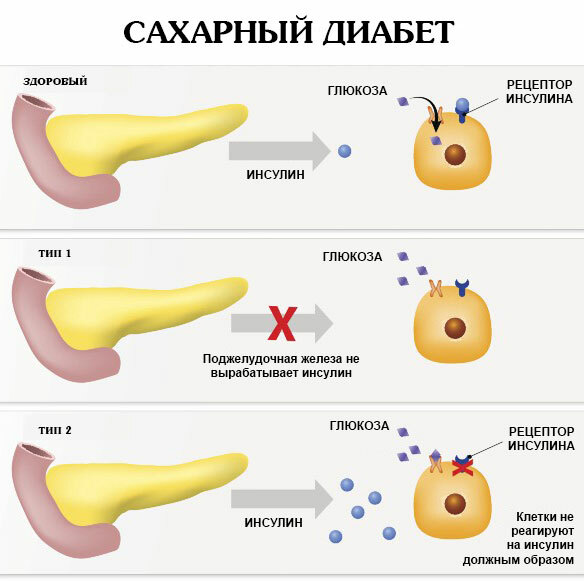
Temporary contraindications include the following conditions:
- acute diseases of a bacterial or viral nature;
- the period after the course of radiation therapy;
- period of bearing the child;
- drug addiction.
General, absolute contraindications include severe forms of diabetes, oncology; chronic diseases of the cardiovascular system, mental disorders.
Since all of these conditions are amenable to traditional therapy, almost every patient can eventually undergo the clasp prosthetics procedure.
Subtleties of care
Clasp denture on the jaw, a photo of which will clearly show the results obtained, should be subjected to regular, but gentle care. For everyday cleaning, a regular toothbrush with the addition of a small amount of paste that is not too abrasive will suffice.
All types of constructions are also susceptible to plaque and food debris, just like natural teeth.
Therefore, for additional care, it is recommended to use other devices besides the toothbrush:
- interdental brushes;
- dental floss;
- irrigator.
Interdental brushes are usually made from plastic materials such as soft silicone, which help to eliminate the risk of injury to the gums.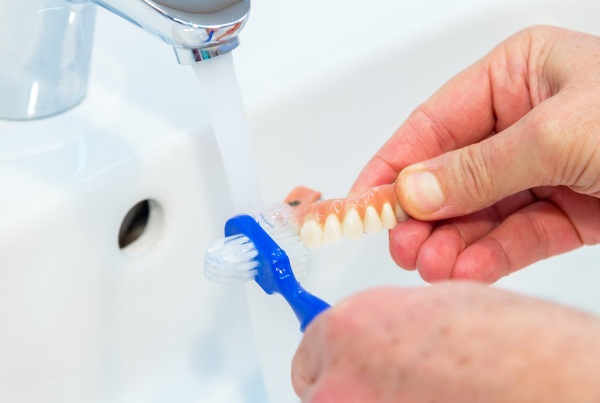
At the same time, with the help of translational-rotational movements, it is possible to completely clean all the interdental spaces from the remaining food particles and accumulated dental plaque. According to the manufacturer's recommendations, such procedures should be performed at least 2 times a day, regularly updating the brushes.
A clasp denture on the jaw, a photo of which shows the preservation of the initial stability of all elements, should be regularly processed and such a device as superfloss.
This is a dental floss, which is an improved version of the standard element that many people are used to. it allows you to gently remove trapped food particles from tight spaces between your teeth.
Thread types are categorized into several distinct structures:
- hard fiber - it consists of a hard tip that easily penetrates the narrow elements of removable and permanent dentures;
- spongy fiber - allows you to remove plaque from braces, bridges and implanted teeth;
- waxed thread - used to cleanse areas for which there are no separate fixtures.
Superfloss can be produced both on the basis of natural silk fibers and from artificial materials, among which nylon, acetate and nylon are widely used. For better glide, some dental floss is additionally coated with a layer of natural or artificial wax.
Clasp prosthesis on the jaw is one of the target areas for the use of semi-professional equipment. These include home irrigators. In the photo of the devices, there is always a convenient stand, a container with water and the device itself. Several buttons and controls are provided for control. The complete set depends on the manufacturer, model, cost and functionality.
It is convenient and simple to use it in everyday life. After studying all the characteristics, each user independently determines with a comfortable mode for the complete removal of all impurities from the spaces between the teeth and the elements of the installed constructions.
Taking into account the possible design options and attachment methods, the clasp prosthesis is a universal opportunity to restore the lost functions of the jaw at the best level.
Photos of the finished results after installation reflect the user experience and confirm that they transfer everything difficulties for the implementation of the task is not too difficult if it is realistic to assess in advance the advantages of modern orthodontics.
Video about the clasp prosthesis
Pros and cons of clasp prostheses:


